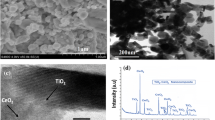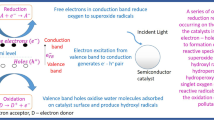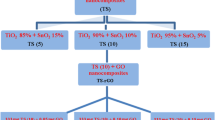Abstract
Development of nanocomposites as efficient photocatalysts for the removal of hazardous organic pollutants is always in dire demand due to increase in water pollution. In this article, a facile sol-gel method has been used to synthesize cerium oxide (CeO2) nanoparticles followed by their decoration over multi-walled carbon nanotubes (CNTs) and graphene oxide (GO) to construct binary as well ternary hybrid nanocomposites using ultrasonic treatment. The oxygen vacancy defects have been depicted using X-ray photoelectron spectroscopy (XPS) that may result into improved photocatalytic efficiency. The ternary hybrid nanocomposites (CeO2/CNT/GO) showed excellent photocatalytic efficiency towards degradation of rose bengal (RB) dye up to 96.9% in 50 min. CNTs and GO provide the interfacial charge transfer which inhibits the electron-hole pair recombination. The results obtained here indicate that these composites can be effectively utilized as promising materials for the degradation of harmful organic pollutants for wastewater treatment.
Graphical abstract











Similar content being viewed by others
Data availability
The data that support the findings of this study will be available from the corresponding author on request.
References
Alharthi FA, Alghamdi AA, Alanazi HS, Alsyahi AA, Ahmad N (2020) Photocatalytic degradation of the light sensitive organic dyes: methylene blue and rose bengal by using urea derived g-C3N4/ZnO nanocomposites. Catalysts 10(12):1–16. https://doi.org/10.3390/catal10121457
Ancy K, Bindhu MR, Bai JS, Gatasheh MK, Hatamleh AA, Ilavenil S (2022) Photocatalytic degradation of organic synthetic dyes and textile dyeing waste water by Al and F co-doped TiO2 nanoparticles. Environ Res 206:112492. https://doi.org/10.1016/j.envres.2021.112492
Arul NS, Mangalaraj D, Ramchandran R, Grace AN, Han JI (2015) Fabrication of CeO2/Fe2O3 composite nanospindles for enhanced visible light driven photocatalysts and supercapacitor electrodes. J Mater Chem A 3:15248–15258. https://doi.org/10.1039/C5TA02630J
Bai G, Wang J, Yang Z, Wang H, Wang Z, Yang S (2014) Preparation of a highly effective lubricating oil additive – ceria/graphene composite. RSC Adv 4:47096. https://doi.org/10.1039/C4RA09488C
Chahal S, Kumar A, Kumar P (2020c) Erbium-doped oxygen deficient cerium oxide: bi-functional material in the field of spintronics and photocatalysis. Appl Nanosci 10:1721–1733. https://doi.org/10.1007/s13204-020-01253-w
Chahal S, Phor L, Singh S, Singh A, Malik J, Goel P, Kumar A, Kumar S, Ankita, Kumar P (2022) An efficient and unique method for the growth of spindle shaped Mg-doped cerium oxide nanorods for photodegradation of p-nitrophenol. Ceram Int 48:28961–28968. https://doi.org/10.1016/j.ceramint.2022.04.145
Chahal S, Rani N, Kumar A, Kumar P (2019a) Applied Surface Science UV-irradiated photocatalytic performance of yttrium doped ceria for hazardous rose bengal dye. Appl Surf Sci 493:87–93. https://doi.org/10.1016/j.apsusc.2019.06.284
Chahal S, Rani N, Kumar A, Kumar P (2019b) Photocatalytic application of lithium doped cerium oxide nanoparticles upon UV light irradiation. AIP Conf Proc 2115:030605. https://doi.org/10.1063/1.5113444
Chahal S, Rani N, Kumar A, Kumar P (2020a) Electronic structure and photocatalytic activity of samarium doped cerium oxide nanoparticles for hazardous rose bengal dye degradation. Vacuum 172(109075). https://doi.org/10.1016/j.vacuum.2019.109075
Chahal S, Singh S, Kumar A, Kumar P (2020b) Oxygen-deficient lanthanum doped cerium oxide nanoparticles for potential applications in spintronics and photocatalysis. Vacuum 177(109395). https://doi.org/10.1016/j.vacuum.2020.109395
Chatterjee P, Mukherjee D, Sarkar A, Chakraborty AK (2022) Mn-doped CeO2-CNT nanohybrid for removal of water soluble organic dyes. Appl Nanosci 12:3031–3043. https://doi.org/10.1007/s13204-022-02611-6
Chen CS, Chen XH, Xu LS (2005) Modification of multi-walled carbon nanotubes with fatty acid and their tribological properties as lubricant additive. Carbon 43:1660–1666. https://doi.org/10.1016/j.carbon.2005.01.044
Everhart BM, Baker-Fales M, McAuley B, Banning E, Almkhelfe H, Back TC, Amama PB (2020) Hydrothermal synthesis of carbon nanotube-titania composites for enhanced photocatalytic performance. J Mater Res 35(11):1451–1460. https://doi.org/10.1557/jmr.2020.97
Gofman I, Zhang B, Zang W (2013) Specific features of creep and tribological behavior of polyimide-carbon nanotubes nanocomposite films: effect of the nanotubes functionalization. J Polym Res 20:258. https://doi.org/10.1007/s10965-013-0258-6
Huang Y, Li R, Chen D, Hu X, Chen P, Chen Z, Li D (2018) Synthesis and characterization of CNT/TiO2/ZnO composites with high photocatalytic performance. Catalysts 8(4):1–6. https://doi.org/10.3390/catal8040151
Karim AV, Selvaraj A (2021) Graphene composites in photocatalytic oxidation of aqueous organic contaminants – a state of art. Process Saf Environ Prot 146:136–160. https://doi.org/10.1016/j.psep.2020.08.042
Kaur J, Singhal S (2014) Heterogeneous photocatalytic degradation of rose bengal: effect of operational parameters. Phys B Condens Matter 450:49–53. https://doi.org/10.1016/j.physb.2014.05.069
Kusmierek E (2020) A CeO2 semiconductor as a photocatalytic and photoelectrocatalytic material for the remediation of pollutants in industrial wastewater: a review. Catalysts 10(12):1–54. https://doi.org/10.3390/catal10121435
Lara-López Y, García-Rosales G, Jiménez-Becerril J (2017) Synthesis and characterization of carbon-TiO2-CeO2 composites and their applications in phenol degradation. J Rare Earths 35(6):551–558. https://doi.org/10.1016/S1002-0721(17)60947-5
Li H, Meng F, Gong J, Fan Z, Qin R (2017) Structural, morphological and optical properties of shuttle-like CeO2 synthesized by a facile hydrothermal method. J Alloys Compd 722:489–498. https://doi.org/10.1016/j.jallcom.2017.06.156
Li Y, Peng YK, Hu L, Zheng J, Prabhakaran D, Wu S, Puchtler TJ, Li M, Wong KY, Taylor RA, Tsang SCE (2019) Photocatalytic water splitting by N-TiO2 on MgO (111) with exceptional quantum efficiencies at elevated temperatures. Nat Commun 10(1):1–9. https://doi.org/10.1038/s41467-019-12385-1
Mathiarasu RR, Manikandan A, Panneerselvam K, George M, Raja KK, Almessiere MA, Slimani Y, Baykal A, Asiri AM, Kamal T, Khan A (2021) Photocatalytic degradation of reactive anionic dyes RB5, RR198 and RY145 via rare earth element (REE) lanthanum substituted CaTiO3 perovskite catalysts. J Mater Res Technol 15:5936–5947. https://doi.org/10.1016/j.jmrt.2021.11.047
Mayyahi AA, Everhart BM, Shrestha TB, Back TC, Amama PB (2021) Enhanced charge separation in TiO2/nanocarbon hybrid photocatalysts through coupling with short carbon nanotubes. RSC Adv 11:11702. https://doi.org/10.1039/D1RA00045D
McQueen N, Kelemen P, Dipple G, Renforth P, Wilcox J (2020) Ambient weathering of magnesium oxide for CO2 removal from air. Nat Commun 11(1):1–10. https://doi.org/10.1038/s41467-020-16510-3
Min C, He Z, Song H, Liu D, Jia W, Qian J, Jin Y, Guo L (2018) Fabrication of novel CeO2/GO/CNTs ternary nanocomposites with enhanced tribological performance. Appl Sci 9:170. https://doi.org/10.3390/app9010170
Mishra SK, Tripathi SN, Choudhary V, Gupta BD (2015) Surface plasmon resonance-based fiber optic methane gas sensor utilizing graphene-carbon nanotubes-poly(methyl methacrylate) hybrid nanocomposite. Plasmonics 10(5):1147–1157. https://doi.org/10.1007/s11468-015-9914-5
Moradi B, Nabiyouni G, Ghanbari D (2018) Rapid photo-degradation of toxic dye pollutants: green synthesis of mono-disperse Fe3O4–CeO2 nanocomposites in the presence of lemon extract. J Mater Sci Mater Electron 29(13):11065–11080. https://doi.org/10.1007/s10854-018-9189-7
Murugadoss G, Kumar DD, Kumar MR, Venkatesh N, Sakthivel P (2021) Silver decorated CeO2 nanoparticles for rapid photocatalytic degradation of textile rose bengal dye. Sci Rep 11(1):1–13. https://doi.org/10.1038/s41598-020-79993-6
Najafi M, Kermanpur A, Rahimipour MR, Najafizadeh A (2017) Effect of TiO2 morphology on structure of TiO2-graphene oxide nanocomposite synthesized via a one-step hydrothermal method. J Alloys Compd 722:272–277. https://doi.org/10.1016/j.jallcom.2017.06.001
Nazim M, Khan AAP, Asiri AM, Kim JH (2021) Exploring rapid photocatalytic degradation of organic pollutants with porous CuO nanosheets: synthesis, dye removal, and kinetic studies at room temperature. ACS Omega 6(4):2601–2612. https://doi.org/10.1021/acsomega.0c04747
Nguyen BH, Nguyen VH, Vu DL (2015) Photocatalytic composites based on titania nanoparticles and carbon nanomaterials. Adv Nat Sci Nanosci Nanotechnol 6:033001. https://doi.org/10.1088/2043-6262/6/3/033001
Palanisamy VK, Manoharan K, Raman K, Sundaram R (2020) Efficient sunlight-driven photocatalytic behavior of zinc sulfide nanorods towards rose bengal degradation. J Mater Sci Mater Electron 31(17):14795–14809. https://doi.org/10.1007/s10854-020-04043-w
Pan J, Wang S, Chen A, Chen Y, Wang M, Chen Y (2022) Visible-light-active mesoporous ceria (CeO2) nanospheres for improved photocatalytic performance. J Alloys Compd 898:162895. https://doi.org/10.1016/j.jallcom.2021.162895
Phor L, Chahal S, Kumar V (2020) Zn2+ substituted superparamagnetic MgFe2O4 spinel-ferrites: investigations on structural and spin-interactions. J Adv Ceram 9(5):576–587. https://doi.org/10.1007/s40145-020-0396-3
Phor L, Kumar V (2019a) Self-cooling device based on thermomagnetic effect of MnxZn1−xFe2O4 (x = 0.3, 0.4, 0.5, 0.6, 0.7)/ferrofluid. J Mater Sci Mater Electron 30(10):9322–9333. https://doi.org/10.1007/s10854-019-01262-8
Phor L, Kumar V (2019b) Structural, magnetic and dielectric properties of lanthanum substituted Mn0.5Zn0.5Fe2O4. Ceram Int 45(17):22972–22980. https://doi.org/10.1016/j.ceramint.2019.07.341
Phor L, Kumar V (2020) Structural, thermomagnetic, and dielectric properties of Mn0.5Zn0.5GdxFe2–xO4 (x = 0, 0.025, 0.050, 0.075, and 0.1). J Adv Ceram 9(2):243–254. https://doi.org/10.1007/s40145-020-0364-y
Qutub N, Singh P, Sabir S, Sagadevan S, Oh WC (2022) Enhanced photocatalytic degradation of acid blue dye using CdS/TiO2 nanocomposite. Sci Rep 12(1):1–18. https://doi.org/10.1038/s41598-022-09479-0
Rani N, Chahal S, Mahadevan SK, Kumar P, Shukla R, Singh SK (2020) Development of hierarchical magnesium oxide anchored cerium oxide nanocomposites with improved magnetic properties and photocatalytic performance. Nanotechnology 31:37. https://doi.org/10.1088/1361-6528/ab96e8
Ruidíaz-Martínez M, Álvarez MA, López-Ramón MV, Cruz-Quesada G, Rivera-Utrilla J, Sánchez-Polo M (2020) Hydrothermal synthesis of RGO-TiO2 composites as high-performance UV photocatalysts for ethylparaben degradation. Catalysts 10(5):1–25. https://doi.org/10.3390/catal10050520
Sharma HK, Sharma SK, Vemula K, Koirala AR, Yadav HM, Singh BP (2021) CNT facilitated interfacial charge transfer of TiO2 nanocomposite for controlling the electron-hole recombination. Solid State Sci 112:106492. https://doi.org/10.1016/j.solidstatesciences.2020.106492
Shekofteh-Gohari M, Habibi-Yangjeh A (2015) Facile preparation of Fe3O4@AgBr-ZnO nanocomposites as novel magnetically separable visible-light-driven photocatalysts. Ceram Int 41(1):1467–1476. https://doi.org/10.1016/j.ceramint.2014.09.081
Singh A, Kaushik V, Chahal S, Goswami A, Nain S (2021) Efficient degradation of methylene blue dye and antibacterial performance of shape controlled RuO2 nanocomposites. ChemistrySelect 6(37):10038–10050. https://doi.org/10.1002/slct.202102546
Soni S, Chouhan N, Meena RK, Kumar S, Dalela B, Mishra M, Meena RS, Gupta G, Kumar S, Alvi PA, Dalela S (2019) Electronic structure and room temperature ferromagnetism in Gd-doped cerium oxide nanoparticles for hydrogen generation via photocatalytic water splitting. Global Chall 3:1800090. https://doi.org/10.1002/gch2.201800090
Su F, Li P, Huang J, Gu M, Liu Z, Xu Y (2021) Photocatalytic degradation of organic dye and tetracycline by ternary Ag2O/AgBr–CeO2 photocatalyst under visible-light irradiation. Sci Rep 11(1):1–13. https://doi.org/10.1038/s41598-020-76997-0
Suman, Chahal S, Kumar A, Kumar P (2020) Zn doped α-Fe2O3: an efficient material for UV driven photocatalysis and electrical conductivity. Crystals 10(4):273. https://doi.org/10.3390/cryst10040273
Suman, Chahal S, Singh S, Goel P, Kumar A, Singh O, Kumar P (2021a) Understanding the role of Ni ions on the photocatalytic activity and dielectric properties of hematite nanostructures: an experimental and DFT approach. J Phys Chem Solid 156:110118. https://doi.org/10.1016/j.jpcs.2021.110118
Suman, Devi S, Sharma V, Chahal S, Goel P, Singh S, Kumar A, Kumar P (2021b) Phase transformation and structural evolution in iron oxide nanostructures. Mater Sci Eng B 272:115329. https://doi.org/10.1016/j.mseb.2021.115329
Suman, Singh S, Ankita, Kumar A, Kataria N, Kumar S, Kumar P (2021c) Photocatalytic activity of α-Fe2O3@CeO2 and CeO2@α-Fe2O3 core-shell nanoparticles for degradation of rose bengal dye. J Environ Chem Eng 9:106266. https://doi.org/10.1016/j.jece.2021.106266
Synowiec M, Micek-Ilnicka A, Szczepanowicz K, Różycka A, Trenczek-Zajac A, Zakrzewska K, Radecka M (2019) Functionalized structures based on shape-controlled TiO2. Appl Surf Sci 473:603–613. https://doi.org/10.1016/j.apsusc.2018.12.114
Tian N, Tian X, Nie Y, Yang C, Zhou Z, Li Y (2019) Enhanced 2, 4-dichlorophenol degradation at pH 3–11 by peroxymonosulfate via controlling the reactive oxygen species over Ce substituted 3D Mn2O3. Chem Eng J 355:448–456. https://doi.org/10.1016/j.cej.2018.08.183
Wang C, Cao M, Wang P, Ao Y, Hou J, Qian J (2014) Preparation of graphene-carbon nanotube-TiO2 composites with enhanced photocatalytic activity for the removal of dye and Cr (VI). Appl Catal Gen 473:83–89. https://doi.org/10.1016/j.apcata.2013.12.028
Wongaree M, Chiarakorn S, Chuangchote S (2015) Photocatalytic improvement under visible light in TiO2 nanoparticles by carbon nanotube incorporation. J Nanomater 689306:1–10. https://doi.org/10.1155/2015/689306
Wongaree M, Chiarakorn S, Chuangchote S, Sagawa T (2016) Photocatalytic performance of electrospun CNT/TiO2 nanofibers in a simulated air purifier under visible light irradiation. Environ Sci Pollut Res 23(21):21395–21406. https://doi.org/10.1007/s11356-016-7348-z
Yang J, Wang J, Zhu L, Zeng W, Wang J (2019) Multiple hollow CeO2 spheres decorated MnO2 microflower as an efficient catalyst for oxygen reduction reaction. Mater Lett 234:331–334. https://doi.org/10.1016/j.matlet.2018.09.130
Zhang Q, Zhao X, Duan L, Shen H, Liu R (2020a) Controlling oxygen vacancies and enhanced visible light photocatalysis of CeO2/ZnO nanocomposites. J Photochem Photobiol A Chem 392:112156. https://doi.org/10.1016/j.jphotochem.2019.112156
Zhang X, Zhou D, Wang X, Zhou J, Li J, Zhang M, Shen Y, Chu H, Qu Y (2020b) Overcoming the deactivation of Pt/CNT by introducing CeO2 for selective base-free glycerol-to-glyceric acid oxidation. ACS Catal 10:3832–3837. https://doi.org/10.1021/acscatal.9b05559
Acknowledgements
S.C. acknowledges the DIT University, Dehradun for the seed money grant (DITU/R&D/2022/017/Physics) and DST-FIST laboratory at DCRUST, Murthal for providing characterization instrumentation facility. P.K. is grateful to J.C. Bose University of Science and Technology, YMCA, Faridabad for the seed award (R&D/SG/2020-21/172) and CIL for instrumentation facility.
Funding
S.C. was financially supported by a seed money grant (DITU/R&D/2022/017/Physics) from the DIT University, Dehradun. P.K. was financially supported by a seed award (R&D/SG/2020-21/172) from J.C. Bose University of Science and Technology, YMCA, Faridabad.
Author information
Authors and Affiliations
Contributions
Surjeet Chahal: investigation, validation, formal analysis, visualization, funding acquisition, writing — original draft; Lakshita Phor: formal analysis, draft writing; Ashok Kumar: supervision, writing — review and editing; Suresh Kumar, Sandeep Kumar, Ravi Kumar: writing — review and editing; Parmod Kumar: writing — review and editing, funding acquisition, supervision.
Corresponding author
Ethics declarations
Ethics approval
The authors acknowledge that the current research has been conducted ethically.
Consent to participate
The consented to participate in this research study.
Consent for publication
The authors consent to publish the current research in the Environmental Science and Pollution Research journal.
Conflict of interest
The authors declare no competing interests.
Additional information
Responsible Editor: Sami Rtimi
Publisher’s note
Springer Nature remains neutral with regard to jurisdictional claims in published maps and institutional affiliations.
Supplementary information
ESM 1
(DOCX 1241 kb)
Rights and permissions
Springer Nature or its licensor (e.g. a society or other partner) holds exclusive rights to this article under a publishing agreement with the author(s) or other rightsholder(s); author self-archiving of the accepted manuscript version of this article is solely governed by the terms of such publishing agreement and applicable law.
About this article
Cite this article
Chahal, S., Phor, L., Kumar, A. et al. Enhanced photocatalytic degradation of organic dye by CeO2/CNT/GO hybrid nanocomposites under UV light for wastewater treatment. Environ Sci Pollut Res 30, 124964–124975 (2023). https://doi.org/10.1007/s11356-023-26184-1
Received:
Accepted:
Published:
Issue Date:
DOI: https://doi.org/10.1007/s11356-023-26184-1




